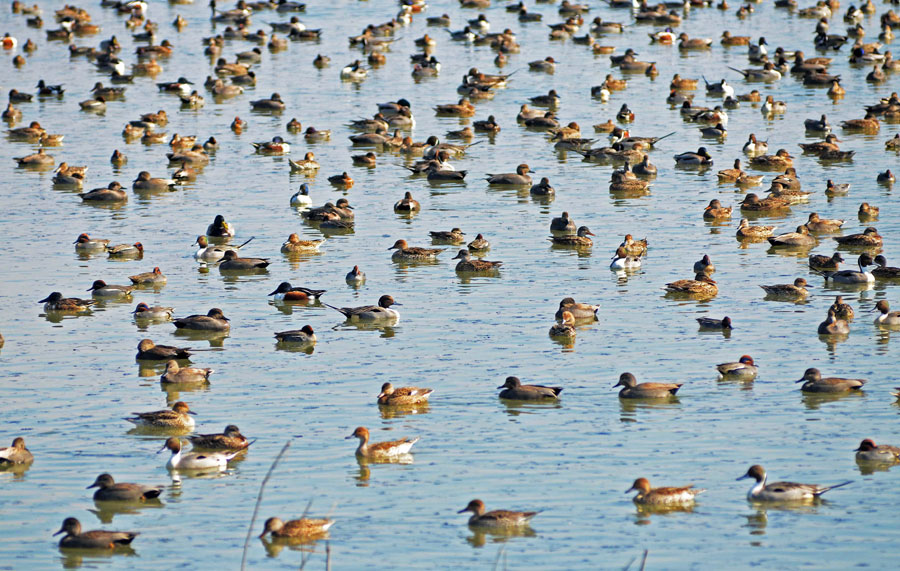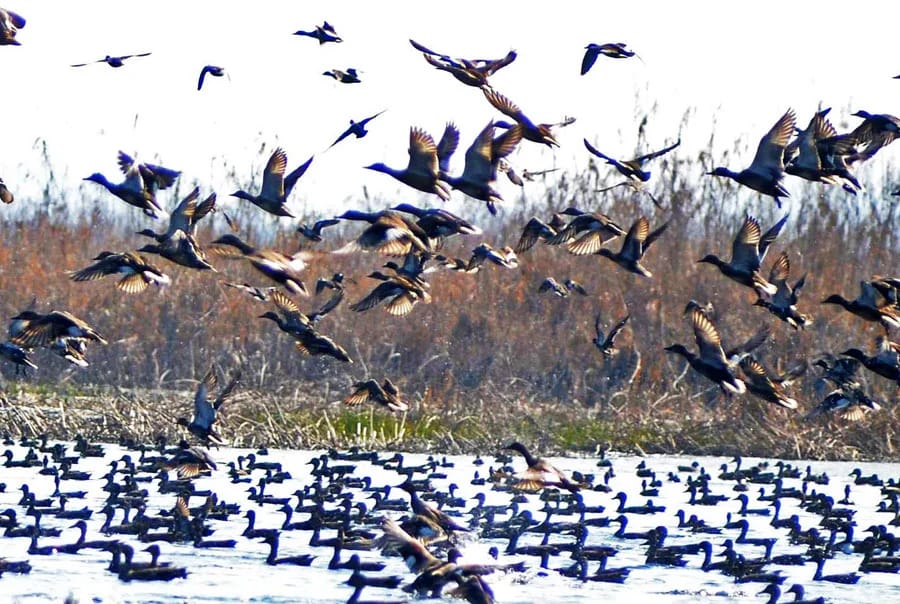By Ajaz Rashid
Kashmir’s wetlands have transformed into bustling sanctuaries for migratory birds, witnessing a record-breaking influx this season. According to the latest census, more than 1.34 million waterbirds belonging to 67 species have flocked to the Valley, marking a 65 percent increase in just six years. This surge is not just a triumph of nature’s rhythms but also a testament to sustained conservation efforts, habitat restoration, and innovative water management strategies.
The wetlands, spread across the length and breadth of the Valley, have long been a winter refuge for migratory birds from Central Asia, Siberia, and Europe. But in recent years, the numbers had been fluctuating due to shrinking habitats, siltation, encroachment, and pollution. Now, with structured conservation plans and continuous monitoring, these fragile ecosystems are rebounding—bringing back the skies filled with wings.
Record Numbers at Iconic Wetlands
This winter, 1,343,506 birds were recorded across 26 wetlands in Jammu and Kashmir. Hokersar, often called the “Queen of Wetlands,” alone accounted for nearly 30 percent of the total bird population, followed closely by Shallabugh at 29.44 percent, while other wetlands together contributed around 40.6 percent.
Among species, the Eurasian Teal (Anas crecca) was the most abundant with 292,039 individuals (22.17%), followed by the Mallard (Anas platyrhynchos) at 226,023 (17.16%), and the Northern Shoveler (Spatula clypeata) at 209,715 (15.92%). Together with other dominant species such as the Northern Pintail, Eurasian Coot, Gadwall, and Eurasian Wigeon, these seven species made up an overwhelming 91 percent of all birds counted.
Long-term data from the Asian Waterbird Census (AWC) between 2019 and 2025 highlights significant population shifts. The Eurasian Teal has consistently remained the top species, with its population peaking at 336,053 in 2022 before settling at just under 300,000 this year—an indicator of the Valley’s suitability for shallow-water feeders. The Northern Shoveler, on the other hand, recorded one of the most dramatic increases: from just 53,868 in 2019 to over 209,000 in 2025.
Conservation Interventions Driving Change
The resurgence of bird populations is not accidental. It reflects strategic conservation and habitat restoration measures carried out in the past half-decade.
One of the most impactful interventions has been the construction of bunds and regulatory gates at major wetlands like Hokersar, Shallabugh, and Hygam. These structures allow better water retention during the critical migratory months, ensuring stable conditions for foraging and roosting.
Equally crucial has been the desilting of clogged areas—a problem that had drastically reduced open-water spaces. Desilting, intensified after 2020, restored water depth and oxygenation, creating ideal conditions for ducks, coots, and waders.
The removal of invasive weeds and the reintroduction of native aquatic plants further diversified food sources and nesting grounds. Peripheral channels were cleaned and reconnected, reducing habitat fragmentation and improving connectivity across wetland zones.
Meanwhile, solid waste management drives near sensitive zones significantly cut down on pollutants that once choked these ecosystems. Continuous water quality monitoring has also allowed authorities to respond quickly to emerging threats like eutrophication or chemical imbalances.

Anti-Poaching and Community Involvement
Beyond ecological interventions, anti-poaching measures have played a critical role in safeguarding this avian revival. Regular patrolling, strict enforcement of wildlife protection laws, and community-driven awareness campaigns have reduced threats during peak migratory influx. Local villagers, once seen as intruders in wetland zones, are now increasingly part of conservation initiatives.
Authorities have emphasized community participation by linking livelihoods to wetland health—be it eco-tourism opportunities, regulated fishing, or controlled harvesting of reeds. This has encouraged people living along the wetland fringes to act as guardians rather than exploiters.
The Numbers Speak
The upward trend in bird populations over the past six years tells the story in clear numbers:
- 2020: 813,043 individuals recorded
- 2025: 1,343,506 individuals recorded
That’s an increase of over half a million birds, or a 65.28 percent rise in just six years.
Officials point out that such growth is not only about the return of migratory birds but also about the improved resilience of local ecosystems. Healthy wetlands act as natural sponges during floods, filters against pollutants, and carbon sinks in the fight against climate change.
A Global and Local Significance
Kashmir’s wetlands are part of the Central Asian Flyway, one of the most important migratory routes in the world, connecting breeding grounds in Siberia and Central Asia with wintering sites across South Asia. The return of birds in such large numbers strengthens India’s position in global conservation frameworks and showcases how local action can have international ecological impacts.
For locals, the return of massive bird flocks is also a matter of cultural and ecological pride. Wetlands like Hokersar and Shallabugh are not just birding hotspots for ornithologists and photographers but also lifelines for farmers and fishermen. Their revival translates into better groundwater recharge, improved fisheries, and reduced flood vulnerability.
Challenges Remain
Despite the positive trends, challenges remain. Encroachment pressures continue to loom large, with agricultural expansion and unregulated construction eating into wetland fringes. Pollution from untreated sewage and solid waste dumping is a persistent issue, especially near urban centers.
Climate change is another looming threat, with unpredictable snowfall and rainfall patterns affecting water availability. Experts warn that without long-term planning, the hard-won gains of the last six years could be reversed.
Looking Ahead
Officials of the Department of Wildlife Protection emphasize that the focus now is on sustaining these population gains. Plans include more advanced hydrological management systems, expansion of community-based eco-tourism, and the creation of bird-watching infrastructure that could turn Kashmir into a global birding destination.

Scientists are also calling for technology-driven monitoring, including satellite-based mapping of wetlands, drone-assisted surveys, and real-time data systems that would allow quicker responses to emerging threats.
A Reborn Paradise for Birds
For now, the sight is one of celebration. As the early morning mist lifts over Hokersar and Shallabugh, the wetlands come alive with the sound of wings—thousands of Teals, Shovelers, and Mallards rising in synchronized flight. For Kashmir, often caught in the turbulence of politics and conflict, these wetlands offer a different story: one of revival, resilience, and the quiet return of nature’s abundance.
The record-breaking bird numbers are more than statistics—they are symbols of hope. They show how science, community, and policy can converge to heal landscapes and restore lost balance. And as Kashmir’s wetlands echo with the cries of millions of migratory visitors, the message is clear: conservation works, and its rewards are written across the skies.